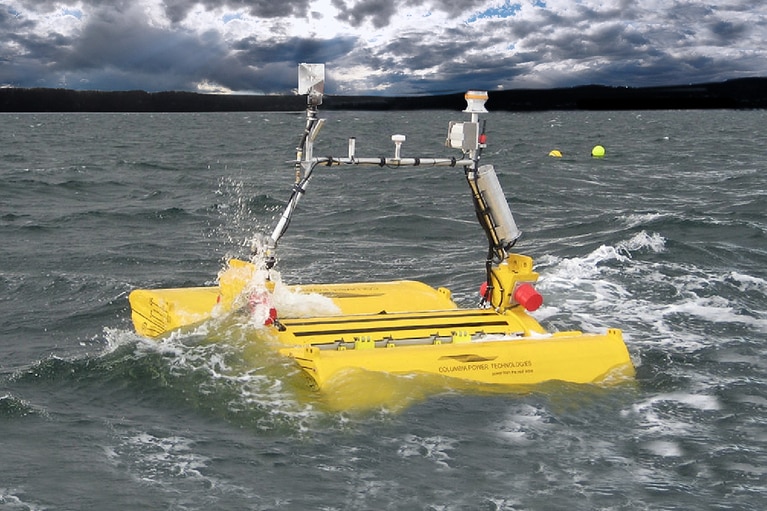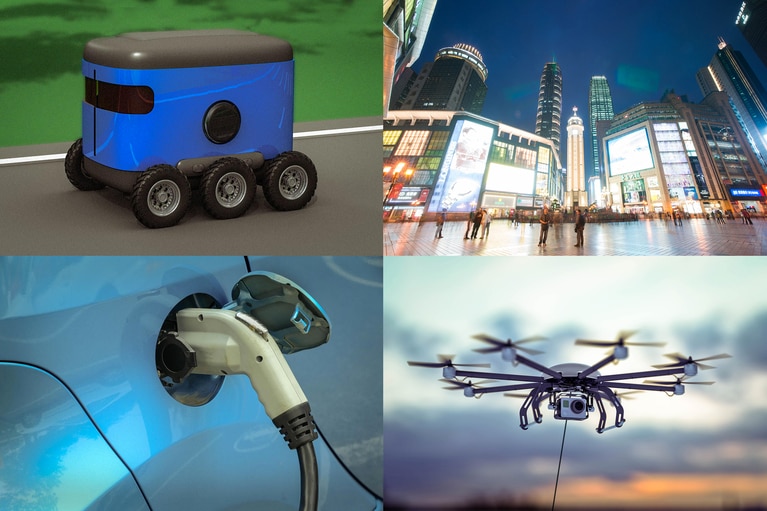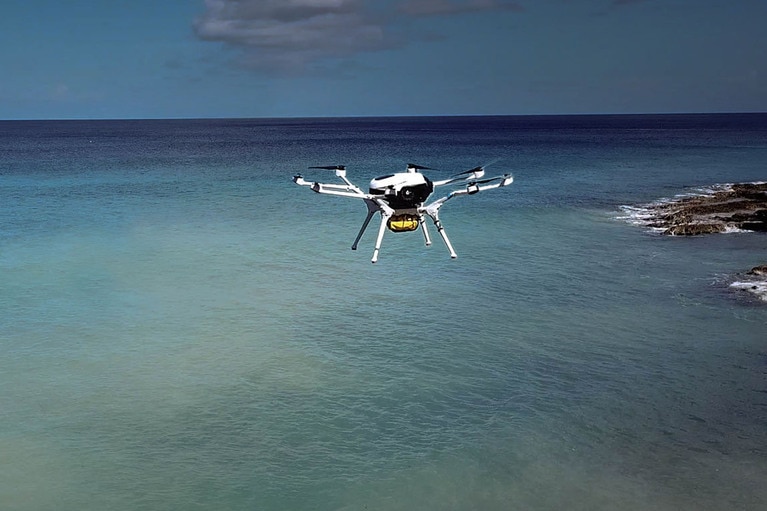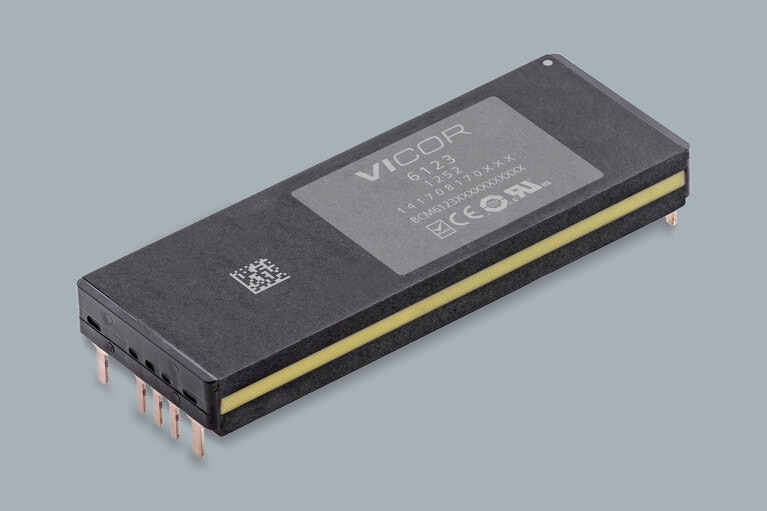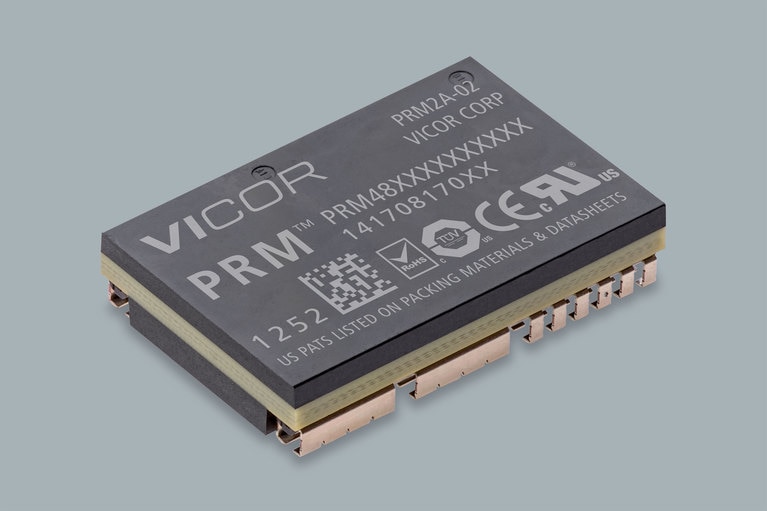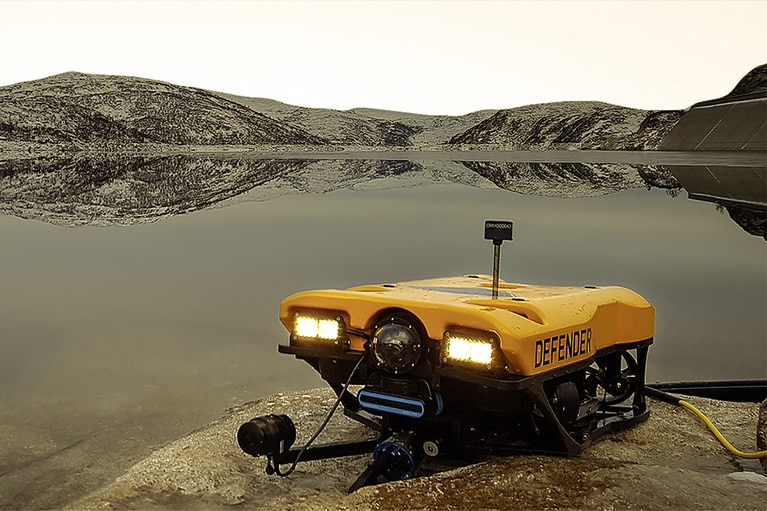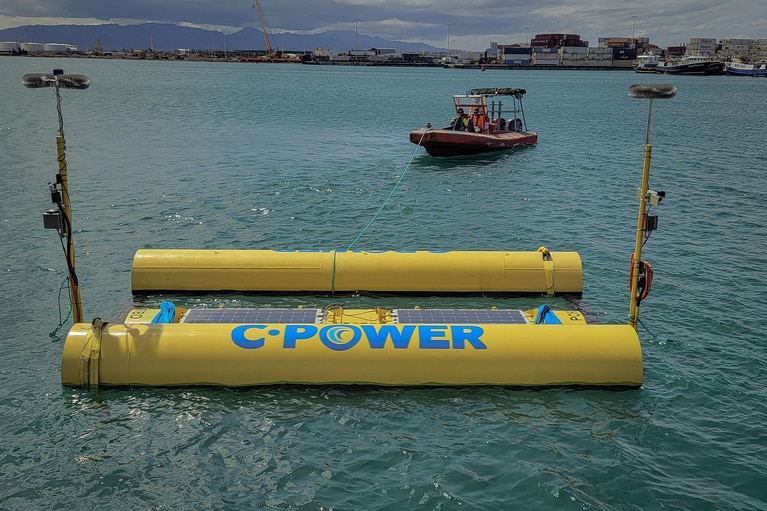
从派克峰到 Bonneville 盐滩,Lightning 的速度超越内燃机摩托车
Lightning Motorcycles 所设计的全电动摩托车在各个领域表现出色。了解 Vicor 电源模块如何支持这款新一代摩托车
Wave power has lagged behind solar and wind, but it has perhaps the greatest potential. Learn how C-Power and Vicor are turning waves in to power.
Podcast with Bill Schmitz, President, Vicor Power Systems, C-Power, CEO, Reenst Lesemann, and Brian Santo, EE Times editor-in-chief with Maurizio di Paolo Emilio. Other guests include NXP, CTO, Lars Reger and Gianluca Pisanello from First Light Fusion.
Wave power has lagged behind solar and wind, but it has perhaps the greatest potential.
SANTO: I’m Brian Santo, EE Times editor-in-chief.
When it comes to renewable energy systems, there are three main energy sources that companies have tried to exploit recently: the sun, the wind, and ocean waves. Solar panels are now practically everywhere. Wind turbine installations are becoming more common on land and out at sea. What we haven’t seen much of, however, is wave power. The new wave in energy might be wave energy, though.
Columbia Power Technologies is one of the companies commercializing wave energy systems. We’ll talk with the company’s CEO, along with the president of Northwest Power, a Vicor company that provides power electronics subsystems to Columbia Power.
Also in this episode, an interview with Gianluca Pisanello, chief operating officer at First Light Fusion. Several companies have recently made great leaps suggesting commercial fusion power might truly be possible, and First Light is one of them.
And as bonus, a brief chat with NXP CTO Lars Reger.
Before we get to our interviews, here’s a quick rundown of some of the stories you can find in EE Times this week:
*Wide bandgap semiconductors, such as gallium nitride and silicon carbide, are in the process of replacing silicon– nowhere more so than in power electronics — but they are also highly appropriate when radiation-hardened devices are required. This week we have an interview with Alex Lidow, CEO of Efficient Power Conversion Corporation. Lidow is one of the leading advocates of wide band-gap materials, and we talk to him about their use in space applications.
The entire industrial world has long depended largely on startups to come up with new technologies and demonstrate that their innovations have commercial promise. Two different startups picked up some significant investment last week. One was AI chip designer Hailo, which attracted $136 million in yet another big-money round for the company. The other was PragmatIC Semiconductor, which collected $80 million it will use to build a new, fast, operationally efficient factory for what it’s calling fab-as-a-service.
If you’re already on this podcast episode’s web page, look to your left; you’ll see links to all these stories. Or you can also go straight to eetimes.com, where you can find these stories along with all our other coverage.
Did your company produce a particularly innovative design this year? Enter it in the Product of the Year competition held by our sister publication, Electronic Products. This is one of the most prestigious product awards in the industry for several reasons. The competition includes all of your fiercest business rivals. This is also one of the most enduring Product of the Year awards in the industry. This will be our 46th year.
What’s an innovative product? Something completely new? Yes, but it might also be something old that’s been improved to have superior performance characteristics. You know what? Achieving a new standard in price-performance is also certainly an innovation.
There’s a link to the submission form on this podcast episode web page, or go straight to the Electronic Products web site, which is right where you’d expect to find it: at electronicproducts.com. The deadline is November 1st. Winners will be announced in January.
The world is turning to renewable energy. Not fast enough — not yet — but it is happening. The classic renewable is hydropower. If it was easy to get away with building enormous dams everywhere, we’d have done it already.
And that is why the world is turning to a new set of renewables, primarily solar, wind, and wave energy. All renewables have a unique combination of benefits and drawbacks. So far, solar and wind are being used fairly extensively. Solar panels power everything from toys to people’s homes. Wind turbine farms are sending energy to the grid.
Wave power has yet to be widely commercialized, but it remains of interest for several reasons. Some of those reasons are obvious. For example, solar works only during the day, and not quite as well with cloud cover, while waves keep coming night and day, and regardless of clouds.
Less obvious is that wave energy has the potential to produce more power with less infrastructure. In terms of peak density, for example, if solar and wind both measure somewhere around a kilowatt per meter square, wave energy comes in at about 25 kilowatts per meter square. No matter the metric used for comparison, the numbers for wave energy are frequently at least ten times better than for solar or wind.
The upshot is that it could be potentially more practical to scale up to megawatts with wave energy than it is with solar or wind. By one estimate, there might be roughly 2 terawatts of power available to be harvested from the world’s coastal waters.
Another very obvious advantage wave energy has is when it comes to ocean applications. If you want to power something far out at sea, you can rely on the presence of waves — not quite everywhere all the time, but close enough.
This is where Columbia Power Technologies comes in. Columbia Power — or C-Power for short — produces three different sized wave energy generators, up through the kilowatt range, that also can include energy storage, along with data and communication services.
We spoke with Reenst Lesemann, CEO of C-Power, and with Bill Schmitz, the president of Northwest Power, a part of Vicor that makes specialty power supplies, including the ones found in C-Power’s wave energy systems.
Reenst, could you explain to us and our listeners what wave energy is and how you actually harvest it?
LESEMANN: Sure, and thanks for having me, Brian, on the podcast today. So wave energy, or let’s say, ocean-renewable energy, encompasses a number of different resources within the ocean. There’s waves on the top, you can have ocean current, like the Gulf Stream. There’s a salinity gradient. There’s a lot of different ways to extract energy out of the ocean.
SANTO: I wanted to talk about implementation. And we’ve got Bill here. Bill, talk to me about what some of the technological challenges are in enabling this stuff. First off, tell me about Vicor. Tell me about Northwest Power. And then let’s talk about some of the implementation challenges.
SCHMITZ: Right. So Vicor is a manufacturer of very dense and efficient power conversion components, a wide array of types of components and types of power conversion. Northwest power, we’re a subsidiary of Vicor. I’ve been here for… I think I started this 27 or 28 years ago with Vicor. Early in Vicor history, actually. And what we do is use Vicor technology in with a mixture of circuits and know-how to develop relatively unique power supplies for applications, obviously, sea power is unique. So it fir well.
SANTO: What’s unique about it? I mean, what is it about wave power? Is it the fact that it’s intermittent? Is the fact that it’s got to be environmentally protected, because sea water’s pretty harsh on electronics, I imagine.
SCHMITZ: It is. So if you don’t discount what C-Power did, there’s a huge amount of analysis to understand it, and then electromechanical design, which resulted in something that is fed to me, which is essentially a pulse of power that kind of looks like the wave. So I suspect if you took a picture of the wave and looked at the power pulse or energy pulse that I get, they would be somewhat similar.
But in power conversion, you regulate the output somehow based on the input voltage. And generally speaking, if you have to go over maybe more like a more than four to one input range, 10 to 40 volts, or 100 to 400, or 200, that’s normal. Well, this energy pulse that’s coming from the generators is a very low frequency pulse. It goes from zero to something relatively high, hundreds of volts, back down to zero, throughout its entire period of time. And the period could be over seconds.
And then furthermore, throughout that pulse, there’s more and less amount of energy at any given time. So in order to try to convert this pulse into something useful and organized, which essentially is a current source, into energy storage devices, the trick is to figure out how to extract that energy all the way from nearly no voltage into all the way up to maybe upwards of 400 volts, and produce a constant current into a storage device and then control that current. So we increase or decrease the amount of current, depending on the pulse and depending on the need. So if you think about loops, there’s a lot of loops in there to try to control the whole thing.
SANTO: But that was easy for you, right?
SCHMITZ: That was a cake. You know, the big trick is to figure out how to use as much standard components — power conversion components from Vicor — because they’re very efficiency and high frequency switching, and the better you can apply those, the more efficient and controlled you can be. And smaller, too. Because we can’t be huge. And a big trick was to figure out the efficiency.
Now, over this huge, wide input range of voltage, essentially, it’s not that easy to get super high efficiency. On the other hand, as it turns out, the super high efficiency is really needed when there’s a lot of power. So as long as we can control it when we’re transferring a lot of power, we’re very efficient. And when we’re transferring a minimal amount of power, we stay operational. We still produce current, we still convert the energy and deal with the efficiency fall-off at the lower power age.
SANTO: So are the C-Power products as refined as they can possibly get as electromechanical systems? Basically, my question is, what technological challenges are left? Are there any fundamental challenges? Or are we talking about technological refinements? And maybe that’s a question for Reenst. And maybe the question also applies to the interface between this electromechanical system that C-Power’s making, and whatever Vicor Northwest Power is providing.
LESEMANN: I can start with that. One of the one of the major challenges is, as I mentioned earlier, and I think Bill refers to, is creating a system that is agnostic to the end use case. We don’t care whether it’s a static asset, or whether it’s a mobile asset, the goal is to create clean-to-condition power in order to keep an asset running, in addition to providing a data connection. I mean, effectively, because we can provide power and a data connection, we’re bringing the cloud to the sea floor, a cloud to the sea surface where there is no connection available.
As far as challenges go, there’s always work to make the system better, stronger, faster, more efficient, again, as Bill was referring to. But we’ve got a system that, again, is going for its pre-commercial application demonstration off the coast of Hawaii, this fall, later this fall. And that’s ready to go.
Where we head from there is going to deeper water. Being able to deploy in the Gulf of Mexico where you’re talking about thousands of meters of water, and there’s an intense need today to bring power to operations in deeper water. And there’s also an intense need to be able to lead these systems out for years at a time. So they have to be marinized. They have to be made survivable and reliable and efficient.
So we’ll always be ready to make it better. But we’re hitting the market today. We’re actually producing two systems, Vicor’s produced two sets of power electronics for us. One, a full scale two kilowatt system, and then one that’s about three quarters scale. Both of those units are in validation testing now, so I think that just underscores where we are that we’re able to start producing multiple units heading out the door here to customers pretty soon.
SANTO: I love the word “marinized,” which you are probably forced to use because “marinated” had been taken.
LESEMANN: We don’t want anything to marinate for sure! So marinized is definitely the way we want to go.
SANTO: And Bill, what are the next technological challenges for you? You had already earlier said making things more efficient. Is there anything about interfacing with the electromechanical systems that C-Power is having and then figuring out where the efficiencies are?
SCHMITZ: So I think it starts with what is next from the C-Power electromechanical. I can’t possibly predict what they might ask me to do next. When they do ask, then I will figure it out.
SANTO: Reenst, we’ll talk about this, okay?
LESEMANN: Well, I’m sure when we first brought this to Bill and to Vicor that it wasn’t at the top of their mind, but they’ve done a great job in helping us solve the problem. So we’re excited about the relationship.
SCHMITZ: Yeah, it was a it was an interesting question when they first approached me. I had no idea how you would think about doing it. But the good news is, I do a lot of weird things. And the weirder it is, the more interesting it is to me.
LESEMANN: Just to underscore that, we’re getting ready to do — off the coast of Hawaii, with our system, which obviously contains the Vicor components. And we’re going to be running sub-sea autonomous vehicle and multiple data gathering systems on the sea floor. That’s never been done with a renewable energy device, with a wave energy device, offshore. So it’s groundbreaking stuff. And that’s an exciting part of it. I mean, it’s exciting for all of us to be able to bring a new renewable resource, really, to mainstream commercial markets, research markets, defense and security markets also. So that’s exciting, but it’s new. We are breaking new ground here.
SANTO: I want to go back to one of the specific applications you alluded to earlier. I was absolutely fascinated to hear about Microsoft putting data centers underwater. The steel industry doesn’t say, Let’s put a foundry under the Atlantic. That’s not something that normally happens. It seemed exotic to me. I don’t expect you to talk about Microsoft itself. But I’m guessing that you’ve at least looked at the phenomenon of underwater data centers and what some of their special needs might be and whether C-Power can play a role. Can I ask you to talk about what you know about what that is?
LESEMANN: Yes, so Project Natick, that Microsoft did. It’s an interesting approach. So the goal for putting a data center under the water is really to save the air conditioning budget. Data centers consume a tremendous amount of power, and a big portion of that — and maybe you or Bill know what the percentage is — but a big portion of that is to keep the equipment cool. So part of the goal for putting a data center on the sea floor is to help reduce that cooling budget, because the seawater is naturally going to keep that system at a reasonable and cool temperature. And it’s easier to dissipate any of the heat that may come off of that.
So we find that’s an incredibly exciting application. And yes, that’s really where you start thinking about megawatt scale systems. Whether you’re running that deep sea or that sea bottom data center, or you’re trying to remove a diesel genset from an offshore fish farm that’s running power for a village. Again, you’re a bit agnostic to what that end use is, but we love that type of application. And it’s definitely going to come! It just makes a tremendous amount of sense. So you’ll definitely see that happening more and more as we go forward.
SANTO: The nature of wave energy. It seems to be as good as you can get. I’ve seen some people complain about when you put a wave generator near shore, some versions of these are supposedly quite loud. Even wind energy seems like it would be an easy thing, but the “not in my backyard” thing, having these big, giant turbines rolling off on top of the hill or off shore, there’s always something. What’s the “something” with wave generators?
LESEMANN: That’s a good question. Noise is certainly always a concern. Are you disturbing mammals or fish, birds with making too much noise? We’ve intentionally designed our system to avoid that type of problem. In fact, we had a system in Puget Sound for 13 months, and they went out to measure the noise, and they couldn’t distinguish our system from the background noise: from shipping and waves themselves. When you have storms, it’s a very noisy place in general. So you really — at least with our system — you can’t distinguish it very well from what’s going on normally.
But sure, anything has a trade-off. But if the world is moving away from carbon, then we need to figure out ways that can reliably and consistently and efficiently supplement or provide primary power. And from our perspective, wave energy, for all those reasons that we’ve talked about already, is a great resource. So there’s a trade off in everything, just like you said.
SANTO: What haven’t I asked about that is interesting, funky, about wave energy?
LESEMANN: One of the things that’s interesting — and this is part of the issue that Vicor has helped us solve — is because it’s an intermittent resource, customers don’t really care about that. What they care about is power, and that their asset, whatever it may be, can run consistently and reliably. And part of the issue is, we always have to keep energy storage somewhere between us and the asset. We can run the asset on a normal basis, but maybe we’re sending too much power down the line and we need to move part of that to the battery. Or it’s flat outside and so the asset needs to live off the battery.
And one of the things that we do to help customers get over that hump, get over that range anxiety, if you will, of how do to have an intermittent resource that can keep something going for five years is, we can look at a site and we can pull 20 or 30 years of historical data. And we can configure a system between capacity, generation capacity and energy storage capacity to say, look, over the last 30 years with this specific configuration, the battery would have gotten below 40% state of charge three times. But if we boost up the battery storage a little bit, then we can assure you, based on historical data, that your system won’t go down.
And I think is that’s a leap that people haven’t quite made yet. I think that’s an interesting thing that everyone’s starting to understand now, is that you can look at what’s going on and configure the system and design it right. And the nice thing about our system, it’s very scalable. So we can do that. And you can ensure that somebody piece of kit’s gonna run for however long they needed to run, whether that’s months or quarters or years.
SANTO: Months, quarters or years is a good place to end. Thank you very much, Reenst. Thank you, Bill.
LESEMANN: Thank you. It’s great.
SANTO: You were just listening to Reenst Lesemann, CEO of C-Power, and Bill Schmitz, President of Vicor subsidiary Northwest Power.
During our conversation we mentioned Project Natick. A quick note on how that turned out. Microsoft built a 40-foot long tube and loaded it with 12 racks containing a total of 864 servers and sank it into the North Sea off Scotland. Power was sourced from a nearby land-based windfarm. Microsoft reports that the servers in the submerged data center showed a failure rate 1/8th that of its land-based control group. The company is continuing with Project Natick.
Finding clean sources of energy is imperative, and while renewables like wave energy and solar and wind power are going to be increasingly versatile and useful, if there’s a holy grail for clean energy, it is probably fusion power.
Every fixed light in the night sky assures us fusion is possible, but no one has ever been able to sustain a fusion reaction on Earth, however. It’s been decades, and minimal progress was made. Until just the past year, when several different companies and research groups began to make extraordinary leaps that seem to indicate that commercial fusion power just might be possible sooner rather than later.
First Light Fusion is one of those companies. It recently finalized the construction of a device it calls the Big Gun. How big is it? It is roughly 72 feet long and it weighs well over 25 tons. What will it be used for? The company has a unique approach to fusion power generation, and it starts by firing a projectile at 20 times the speed of sound at a fusion target.
First Light’s approach is based on inertial confinement, seeking to subject the fusion fuel to extremely high compression in a very short time, and then use the inertia of the fuel itself to maintain those conditions long enough to trigger the fusion reaction.
Maurizio di Paolo Emilio is the editor-in-chief of Power Electronics News, and a contributing editor to EE Times. Here he is with Gianluca Pisanello, chief operating officer at First Light Fusion.
di PAOLO EMILIO: Let’s start with the concept of fusion. What are the features that can make fusion energy a reality? How does a fusion reactor work? And from your experience, from your point of view, why do you think this is an important energy resource for the planet?
PISANELLO: Absolutely. Thank you. Fusion is, in a nutshell, a very small nutshell, fusion is the process that generates energy by fusing — by putting together — two like atoms to make a slightly heavier one. And in this process, a neutron is also generated, which carries a lot of energy.
Now, in contrast, the current nuclear energy uses the opposite concept. They start from a very heavy atom, and they split it. And when you split a heavy atom, you also get energy. When you fuse very light atoms, you also get energy, and you actually get more energy. Now, this is a little bit counterintuitive. But in this short time, I can’t really explain that. But the physics work in exactly this way: When you have heavy atoms, you get energy by splitting them; and when you have light atoms, you get energy by fusing them. This process, the process of fusion, is what happens at any time in the stars, obviously, including the sun. So the energy coming from the sun is fusion energy in fact.
The reason why fusion is so attractive is because it has a series of very, very important benefits. First of all, it’s clean. It’s absolutely clean energy. The amount of raw material is practically limitless; you only need water for the deuterium, and then you need lithium in order for the reactor to then produce the other component that you need for the fuel, which is tritium.
Unlike current nuclear, it also doesn’t have a lot of other negative aspects. For example, in a fusion reactor, you cannot have meltdown events like Fukushima or Chernobyl. So you cannot have catastrophic events. Because in a fission reactor, in a nuclear reactor, current nuclear reactor, you have to put an enormous amount of effort for the reaction to not run away, to not become explosive in a way. Whereas in a fusion reactor, you have to put an enormous amount of effort for the reaction to actually continue.
As soon as there is an interference, something that doesn’t work, by its own physics, the process automatically stops. It’s not a chain reaction that wants to continue and grow.
The other big difference with nuclear is that nuclear waste — which is a major, major issue for nuclear — is orders of magnitude smaller problem with fusion. The radioactive waste in fusion is short lived. We’re talking decades, rather than tens of thousands of years as it is in nuclear. And they typically have low or intermediate level waste. So there’s no high level waste, which does happen in nuclear.
And finally, you cannot use products that you find in a fusion reactor to make nuclear weapons. Again, unlike in current nuclear. This way, this makes fusion extremely more attractive than nuclear, and obviously extremely more attractive than polluting sources of energy.
di PAOLO EMILIO: Yeah. So let’s move into your technology. Your technology is based on an inertial confinement, so can you tell me more? What is the most critical step in this fusion? And so the main challenges. The main challenges to achieve a commercial step for fusion for everyone.
PISANELLO: Absolutely, the approaches to fusion, the two mainstream approaches to fusion, they differ mostly on how they contain the so-called plasma. In order to achieve fusion, you need extremely high temperatures. We talk in the order of 100 million degrees. And now obviously, containing that material matter at that temperature is a big challenge. And this is where the two different approaches differ.
One is called magnetic fusion, where basically they use like a magnetic field or magnetic bottle to hold this plasma. And the other approach, which is ours, is called inertial fusion. So what we do in inertial fusion is basically we try to make the process happen so quickly — so to bring the fuel at that extreme temperature and extreme pressures as well — so quickly, that by its own inertia, the plasma doesn’t have the time to relax; it doesn’t have the time to cool down before the fusion reaction actually happens.
This approach, which is also one of the mainstream approaches, the most famous, probably, laboratory research, industrial fusion is the National Ignition Facility in California. It’s the United States National Lab. We use a different approach for the same branch of fusion research.
Our approach, which is based on projectiles, has many advantages. They all stem from the fact that we can keep the expensive and sophisticated bits of the plant away from where the reaction happens. And this brings a lot of advantages in terms of maintenance and life of the plant.
di PAOLO EMILIO: Yeah, good. So in terms of fusion, we have a lot of investment into the research and development of this new energy. So you can tell me more in this case. So a lot of an investment that will drive a moral realistic view or this technology to provide reliable electricity. So from your point of view, from your experience, how do you see the future of energy? And where would you suggest is the challenge to have any fusion energy for the market?
PISANELLO: Yeah, absolutely. Like I said, I joined at the beginning of 2016. And since then, it has been a very, very exciting time to be in this sector. There is more and more interest, both from private entities and from public investment point of view. And not only in terms of money, but also in terms of governments actually pushing forward to develop a regulatory framework for fusion. So fusion is really coming. It’s real. Governments talk about it, private investors talk about it. There is a relatively big number of private enterprises research in the field. So this is super exciting.
Why do we do that? We do that because we strongly believe — and with First Light, we have also commissioned a study to understand the energy market in 2040. And we strongly believe that while we should develop and continue to deploy renewable solutions at the maximum possible pace, we know that there will be, if we don’t find a clean form of base-load energy, so something that works day in, day out, day and night, we will have a gap in terms of how much energy we can provide with renewables only.
So that gap is huge by 2040. Even with an aggressive scenario of renewables deployment, which we all advocate for, we will still be able to cover about half of the projected demand of electricity. So this is why developing a clean base-load technology like fusion is fundamentally important. And like I said, governments and private investors now really understand this.
di PAOLO EMILIO: Yeah, totally agree. Thanks a lot, Gianluca. It’s been a pleasure to talk with you about fusion. Thank you.
PISANELLO: Thank you very much, Maurizio, for inviting me. And all the best.
SANTO: That was EE Times editor Maurizio di Paolo Emilio with Gianluca Pisanello, chief operating officer at First Light Fusion.
A couple of weeks ago, EE Times held its AI Everywhere virtual conference, with tracks on edge AI, tiny ML, and AI in the data center. Keynote speakers included executives from IBM Research, NXP, ABI Research, Edge Impulse, IMEC, and many more. If you missed it, all of the AI Everywhere content is now available on demand, including keynote presentations, technical talks and panel discussions. It’s all available on demand at www.ai-everywhereforum.com. It’s there until the end of October. There’s also a link on this podcast episode’s web page.
Lars Reger is the chief technology officer of NXP Semiconductors. He’s been an occasional guest on this podcast.
Nitin Dahad is the editor in chief of Embedded.com and a contributing editor to EE Times. He caught up with Reger a week ago, just before the ITS World Congress held at the end of last week. This is a show for transportation infrastructure and transportation technology. That includes vehicle-to vehicle-communications and vehicle-to-infrastructure communications. The “nerdhand” for that is V2X.
The two had a wide-ranging conversation about smart cars and smart cities. Here are Nitin and Lars.
DAHAD: You’re specifically showing how the V2X is already being deployed or is deployed, using e-bikes as an example. Is that right?
REGER: Yes. So, of course we are trying to show how you in an optimal way do smart traffic management. And you have heard us talking a lot in the past years about how we can use our car-to-car communication or V2X technology to smooth traffic flows, have cars talking to each other, cars to traffic lights. So how the infrastructure around us is managed in an optimal way. And what we are doing here in Hamburg is, we are also showing how, for example, the bicycle riders, e-scooter drivers can be seen by the other systems around them to avoid accidents.
Now, it is the same silicon, the same hardware, same software, but of course a very different means of transportation. And that is a pretty cool use case, especially because there is e-bicycles, a very big portion becoming visible in our cities. E-bicycles are the most used electric vehicles in Europe already today. And they are accounting for a pretty high amount of severe accidents. Simply because people are not used to the acceleration speed, or different behaviors in the normal traffic patterns.
So having already a bicycle with a battery, but it’s of course the perfect landing place to put two or three chips next to the battery and transmit, Hey, I’m a road user; I’m here; please all pay attention. And this will be done.
DAHAD: Okay, now I’m taking it a little bit wider. I think you’re talking about beyond the smart traffic management and some of the scenarios that you can see by ITS, but also some of the examples. I think you talked about smart parking and various other things. Can you just give us some examples of what is doable and what’s going to be shown and maybe some visionary stuff as well?
REGER: Yeah. What you see already today, we have, for example, Volkswagen cars series, production cars, So the Golf 8 or the ID 3 and 4. They already fully equipped with respect to V2X technologies. We have a complete cities already that are rolling out, and every traffic light obviously V2X technology so that the traffic lights and the cars can talk. And you have fast acceleration that you can see here. Truck, road, train forming so we have multiple trucks are getting connected together. So the first truck is basically driving and the others are following as virtual trailers.
And what you’re seeing is now the rollout in the e-bikes, but they’re honestly the most sexy use case that I have seen here and that I’m looking forward to next week.
Plus also a use case that you can implement as of today is smart valet parking. So you bring the car to the park house. You get off the car, and the park house system takes over your vehicle, manages it via V2X technology and cameras in the building. And then the car gets driven autonomously into the park house, is washed there, is charged there, and is parked. And of course, if you want to have it back, you just tell your mobile phone or the parking system, Get me my car back out. And this autonomous valet parking system brings you your car back.
That is a technology that we have already today. We are installing it in a couple of park houses here in Germany already. And that is of course hopefully changing the appearance of our smart cities in the coming years.
DAHAD: That does rely on the car having V2X. Is that right?
REGER: Yeah. So that is using V2X technology at the moment, simply because this is a very ruggedized, robust means of communication. I mean, you know that there is a lot of steel and concrete, of course, in these parking houses. You need to rely, of course, on robust signal exchange, and also delay- free signal exchange. And that is what car-to-car communication — 802.11.P — was made for initially. And of course, what you’re doing is, you then need to have a car that is equipped with the drive-by-wire system so that the electronics can steer and brake and accelerate. But that’s it.
And on that simple, smallest common technical denominator, we can equate the use case. And some of the of the partners fought, for example, a continental cup and equals some other companies here, they are helping, of course, installing these use cases,
DAHAD: One of the things I think was quite important actually is, you’re gonna be generating lots of data. And you’re not sort of sending that data somewhere because it’s a mesh network. That’s 802.11.P is basically enabling that data to stay within that locality.
REGER: Very honestly, when we all talk about mesh networks in our WiFi systems in our houses, I mean, this year, what we are talking about, this 802.11.P V2X networks are, since 10 years, maybe the broadest range, really, in terms of meters in distance, broadest range mesh networks that you can think of. And if you have an entire traffic system in a city that has a mesh network, that’s a pretty cool, technical thing. And yeah, it shows also how you can implement it very robustly. And what the benefits for a smart city are.
You save a lot of concrete and road works. You don’t need acceleration lanes, but you can have smart electronics managing the traffic flow in an optimized way in a city.
DAHAD: I think that smart city concept where the dream of being able to manage everything very cleverly, and changing the cycles of the traffic signals, for example.
REGER: Absolutely. I mean, if you’re talking about smart devices around us, if you’re talking about the world that anticipates and automates for basically the…
DAHAD: …Which has been your mantra for a long while now.
REGAR: That’s it. I mean, yeah, and indeed, of course, it takes quite a while. That’s a good point. It takes, of course, also a while to have the infrastructure in the vehicles adapting to the technology. So we, as techies, we talk about it since educate, maybe, and the dreams are there. To bring it into realization, we just see happening now. We see our houses very quickly become smart homes; we have voice assistants, all of these type of things around us; we see the cars getting more and more connected and becoming more smart. And of course, also the infrastructure in our cities.
But the automotive and the infrastructure investment cycles, they are not like in consumer electronics, that takes you five, eight, ten years to renew the technology. And this is why it also takes quite some years to see that.
DAHAD: Lastly, I mean vision of what you’re going to be showing it is not just now but also a vision of what smart cities will look like in 30 to 40 years. Can you talk about that a little bit?
REGER: Yeah, absolutely. If you just imagine that now, what you see here in different showcases is coming together and is merging into one. It’s a seamless experience, city experience. That of course starts changing the appearance of the city itself again. How much parking space do you need? How wide do the streets need to be? How is your traffic management system over the different traffic lights? Do you need to do different road constructions or can you avoid that? Do you have acceleration lanes for bicycles? And so on. That all will over time change, of course, significantly the setup of how cities will look like. And that is what you’re going to see. Takes again 20 years plus maybe to see the reaction of the city to the technology, but it’s going to come.
DAHAD: Lars, thank you very much.
REGER: My pleasure.
SANTO: That was EE Times editor Nitin Dahad with Lars Reger, CTO of NXP.
Bill Schmitz, President, Vicor Power Systems
Graduated from Gonzaga University in 1985 with an Electrical Engineering degree. Following graduation owned a consumer electronics company selling and servicing electronics. In 1987 I moved to Portland Oregon to work for a power supply company as a sustaining engineer performing root cause failure analysis, and then ultimately as a design engineer for custom discrete commercial and military power supplies.
In 1995 I co-founded Northwest Power as a subsidiary for Vicor Corp. to design and manufacture custom power supplies using Vicor components as core components.
This podcast was originally published by EE Times.
Case study: Harnessing ocean waves to power remote marine applications
Vicor Power Systems: High-performance power supplies to solve the toughest problems
Case study: Accelerating coral reef growth using renewable energy and factorized power
Case study: World’s first commercialized hydrogen fuel cell power pack for UAVs
BCM6123TD1E5135T0R bus converter
PRM48BF480T600A00 buck-boost regulator
从派克峰到 Bonneville 盐滩,Lightning 的速度超越内燃机摩托车
Lightning Motorcycles 所设计的全电动摩托车在各个领域表现出色。了解 Vicor 电源模块如何支持这款新一代摩托车
HIRO 利用高性能微型数据中心将欧洲推向边缘计算的前沿
从支持脑部手术到推动节省成本的智能工厂 —— HIRO 正在利用创新的计算概念将欧洲推向边缘计算的前沿
VideoRay 利用 AI 及当前最新技术推动安全、高效的水下探索
Vicor 电源驱动创新播客讨论了水下机器人应用的激增以及 VideoRay 如何应对新的水下任务
地球上最好的电池是免费的,它正在为蓝色新经济提供动力
C-Power 自主海上发电系统 (AOPS) 漂浮在海面上,捕捉机械波能并将其转化为可用的电能

